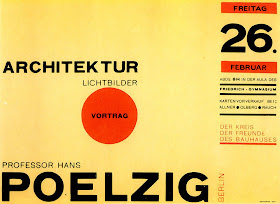 |
| Erich Consemüller, Lis Beyer or Ise Gropius sitting on the B3 club chair by Marcel Breuer and wearing a mask by Oskar Schlemmer and dress fabric by Beyer, c.1927 |
Bauhaus: Art as Life is at the Barbican until 12 August. The exhibition is a substantial examination of the work and ideas of the world's most famous art school. The Bauhaus existed for a mere 14 years, 1919-33, as a bold utopian creative community in the turbulence of pre Nazi Germany. Led, initially, by the visionary architect and educator Walter Gropius, the Bauhaus brought together an extraordinary group of Modernist artists and designers, including, Wassily Kandinsky, Paul Klee, László Moholy-Nagy, Josef Albers, Marcel Breuer and many others; collectively they left a definitive mark on the art, architecture and design of the twentieth century.
Adrian Searle reflects on the state of art education today in his review of the exhibition:
There is a lesson here about much contemporary art education: the lack of common purpose, the overweening bureaucracy, the disillusionment and grasping for fees, the box-ticking lostness of so much of it. The Bauhaus had a sense of common purpose and shared ideas, of arguments that meant something, of making things up as you go along. And so much that it gave us was practical, and a delight to the eye. No wonder the National Socialists wanted it closed.Read Searle's review and articles by Fiona MacCarthy and Rowan Moore.
 |
| Walter Gropius, Bauhaus, Dessau, 1925 |
 |
| Walter Gropius, Bauhaus, Dessau, 1925 |
 |
Herbert Bayer, Kandinsky zum 60.
Geburtstag, 1926
|
 |
| Marianne Brandt, Tea pot, 1925 |
 |
| László Moholy-Nagy, Prospectus cover for14 Bauhausbücher (14 Bauhaus Books), 1928 |
 |
Herbert Bayer, Architektur Lichtbilder Vortrag Professor Hans Poelzig, 1926 |
 |
| Josef Albers, Factory A, 1925/26 |
 |
| Farkas Molnár, Entwurf für ein Einfamilienhaus, 1922 |
 |
| Marcel Breuer, Wassily chair, 1925 |
 |
| Walter Gropius, Bauhaus, Dessau, 1925 |
No comments:
Post a Comment